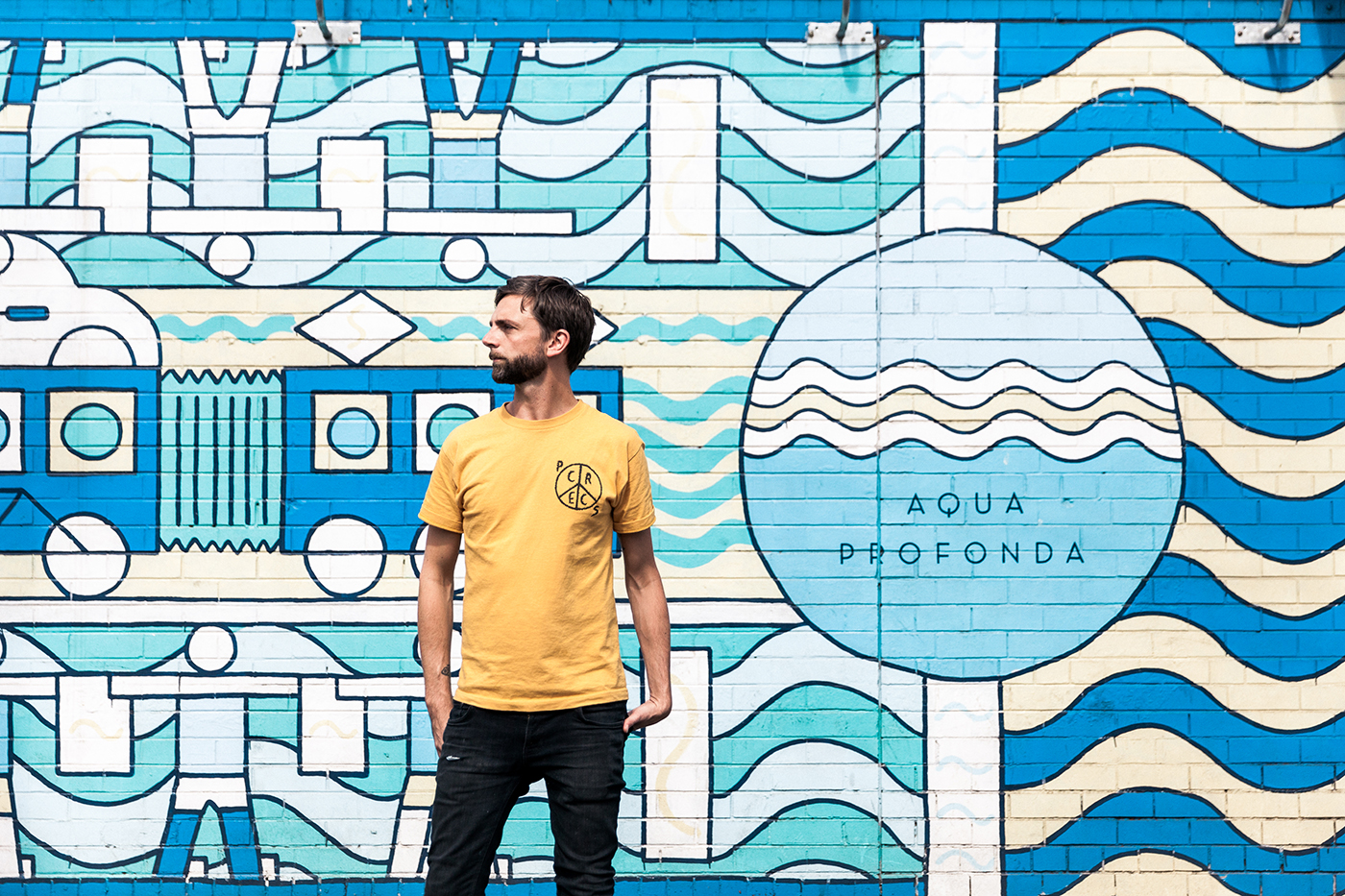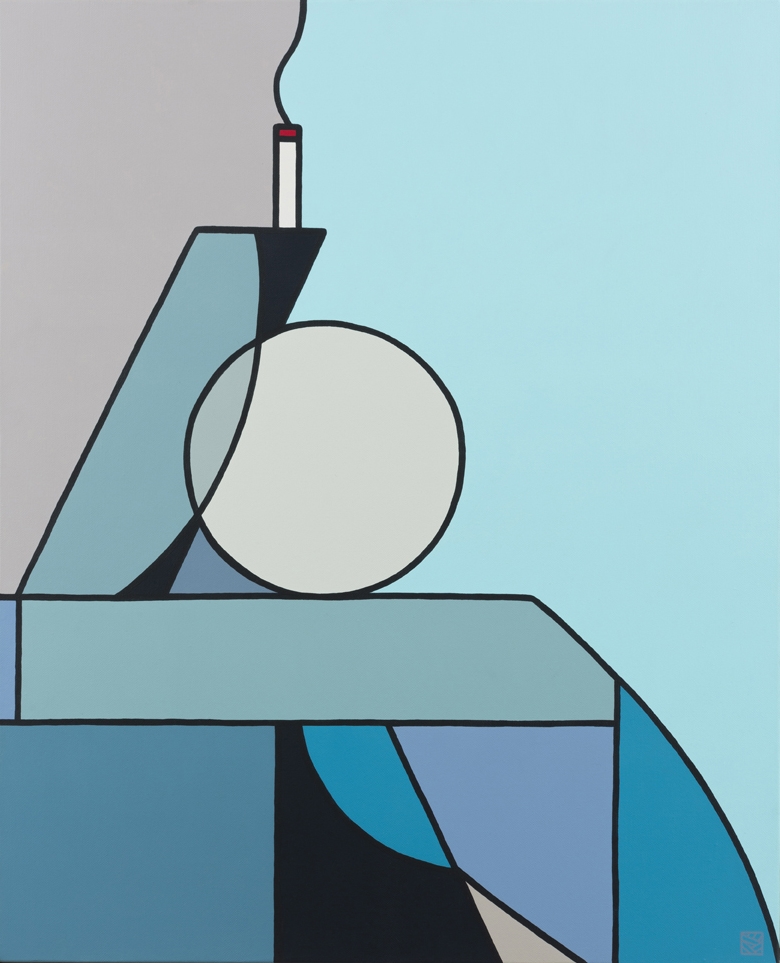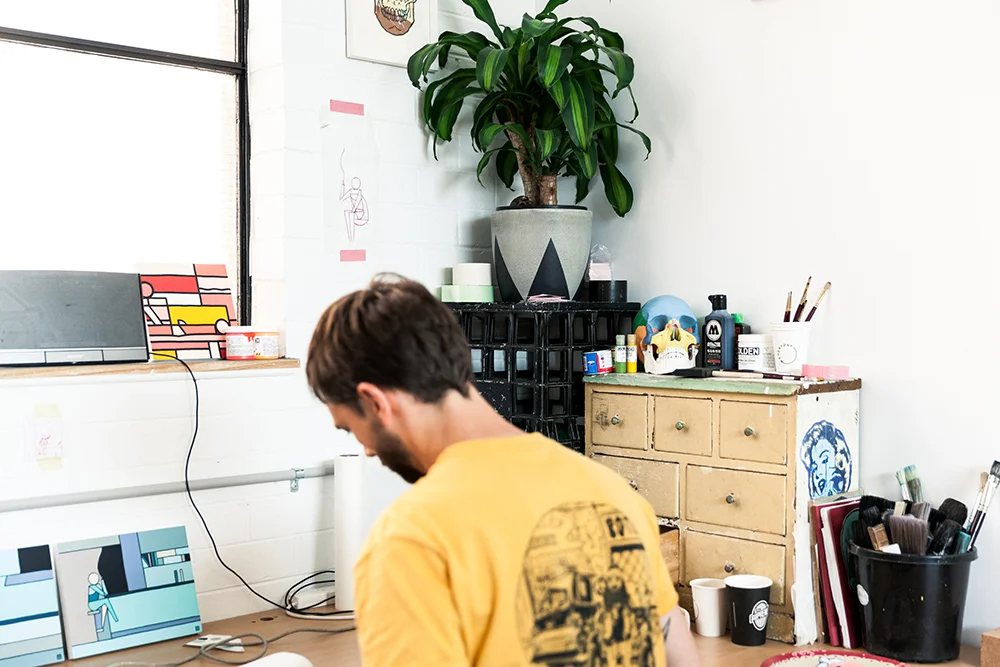Geometric Cinema: In Studio with Artist Stephen Baker
/For Stephen Baker, every color and every painting’s palette is chosen as carefully as the bold lines and forms which shape his scenes. A typical scene might feature a figure carefully blocked, built up with trapezoids, rectangles, and spheres, and with a single wavy line smoking up from a cigarette. His figures evoke confidence: women in powerful poses, a man seated in potent reflection, or more complex scenes whose geometries imply noir-like narratives.
A suburban child, Baker found his inspiration in the skateboard scene, drawing from this culture as much as from the album art of his favorite metal music. He drew, mixed and dubbed his own radio shows, and hung out with older kids. Eventually, his love for artists like H.R. Giger, cinematic and surreal, led him to study art and design in school. After working as a graphic designer and commercial artist, he took inspiration from street artist Rone to develop his own artwork. Now, Baker’s painting pursues “scenes that hold strong lines, are quite architectural in a sense, and that also evoke a certain feeling or mood.” Composed in such palettes as tea rose, persimmon, and peach, or blue-gray, teal, and ecru, his work is bold, but uncomplicated - a subtle mastering of composition which challenges our notion of the cinematic.
“What captures my attention for these sketches are those scenes that hold strong lines, are quite architectural in a sense, and that also evoke a certain feeling or mood”
K: Who is Stephen Baker? Where did you grow up and what was it like?
SB: I grew up in the eastern suburbs of Melbourne in East Doncaster, went to school in an outer fringe suburb of Melbourne called Eltham. I studied art and design through high school and then a year at Brighton Bay Art/Design/Photography program before settling into a 3 year Bachelor of Art & Design at the Swineburne School of Design, Prahran. My upbringing was fairly standard for a suburbs kid I think during the mid- to late- eighties. I skateboarded with local kids, listened to metal bands, played drums, watched horror movies religiously and enjoyed drawing detailed gory skulls with eyeballs falling out of their sockets… normal stuff. I always have fond memories of a Coolstore up the road where we’d all hang out (I was the youngest in the group, and always preferred the company of kids older than me).
It was this large apple Coolstore factory. We knew the owner’s son and we’d skate in and out of the large Coolstore rooms after school with the stereo cranked. In the summer it was great because you’d stay chilled from the large dark cooling rooms even though it would 36 degrees (Celsius) outside with the sun belting down. We built a halfpipe out of wood laying around the factory and some large sheets of ply. We’d climb 3 stories up on empty apple crates and play war, or hide and seek. Once, my sister stepped on the fingers of the owner’s daughter as she was climbing up the apple crates and she fell straight down and broke her arm. So this place became the hangout for a few of us kids in the area.
K: When did art enter your life, and what led you to the present?
SB: I was really influenced by the artwork of the skateboard scene and also the metal bands I was listening to. Lots of dark detailed drawings from the likes of Pushead and H.R. Giger really influenced me and fueled a desire to start drawing. This, and also having a fairly creatively-minded father led me towards the arts. I was always getting books on how to draw dinosaurs or sets of coloured texts from my grand parents as birthday gifts. As far back as I remember I was always into drawing detailed real life pencil works. I used to draw pictures for kids at school; NBA stars like Jordan and Pippen were always a favourite.
In the end I found myself more in the design field than straight arts as I thought I’d survive a little easier with a design degree under my belt. I think having the skills as a designer has really helped with the my artist ventures. As the years passed, I slowly started getting known more for my artwork. I’m only recently coming to realise that I’m an artist now, it’s what I do for a living.
K: What's your most prized possession? What's something you can't live without?
SB: Music. I couldn’t survive without my music. I’ve always listened to music since I was a child, from the time I wake till the time I fall asleep. When we were kids my sister and I would tape record our own radio shows, creating characters that would be interviewed between songs we’d dubbed from the real radio.
I have a fairly large collection of albums on cassette, CD, and also vinyl that I’ve been collecting ever since I was around six. I couldn’t think of a world without my music - it has to be there within arms-reach at all times.
K: Favorite tools and materials to work with?
SB: I think when it comes down to it I would find it hard to pass up the everyday BIC biro as my favourite tool to use. That, and also an A5 size Moleskine notebook. It’s all you need to start some of the biggest projects.
K: Where’s your favorite place to think or be inspired?
SB: Not that I get there enough these days but spending a day at the botanical gardens in the city is such a nice place to just sit and think. There are so many amazing plants, and a unique bird life in the gardens, it’s just such a peaceful and beautiful place to collect your thoughts. I also find that the NGV (National Gallery Of Victoria) is endlessly inspiring. I actually overload on ideas when I’m walking around that place; I’ll often leave with fifty new hare-brained ideas for a show or collection of works.
K: How would you describe your design aesthetic?
SB: A minimalist reinterpretation of the world around me that’s both distinctive and familiar.
K: What about in one word?
SB: Bold
K: What initially captures your attention for a potential subject? Do you draw ideas from your sketchbook, or start with the canvas?
SB: I’ll most likely start from a sketch I’ve drawn in my notebook and then size that up for the canvas. What captures my attention for these sketches are those scenes that hold strong lines, are quite architectural in a sense, and that also evoke a certain feeling or mood.
K: How would you describe your studio? What in your opinion makes an ideal environment for working?
SB: It’s not an overly-large space but there are communal areas where I can bust out some large pieces. I have a lot of reference books, and my materials close at hand. Some days I’ll work from home because there’s a huge downstairs area I can utilize. I enjoy having multiple areas to work from; it tends to get less tedious and shakes it up a bit. Mostly, a nice amount of natural light and a decent stereo playing tunes is all I need for a good working environment.
K: You started as a commercial graphic designer, working predominantly in clothing while your personal projects were reserved for any off-time you had. How did you make the switch to focusing solely on your own work? Was there a specific moment or inspiration that prompted the shift?
SB: I was about to say there wasn’t really one moment but that’s a lie. There was a definite moment when I was working as a graphic artist at Mooks clothing label years ago. I had the chance to commission artists for tee shirt prints. It was there I met the street artist Rone, who at that time developed artwork for us. Just seeing him putting 150% into developing his craft gave me the kick in the butt I needed to get out there. I saw what he was doing and I wanted to do it as well . . . it’s as simple as that. He was definitely inspiring to me at the time, and still is, as are so many creative people I’ve come in contact with since. I’m inspired by anyone who is dedicated and works triple time to get where they want because they love what they do.
K: Who are some of the illustrators and designers who are really influencing and inspiring you currently?
SB: Since I got back from my last trip to Japan, I’ve been in awe of artists Shinro Ohtake and also Keiichi Tanaami. Both have an amazing breadth of graphic-styled artwork and illustrations. I now have some amazing books from each artist which I constantly use for inspiration. I’m also always inspired by the works of American artist Matthew Barney; the levels of detail he undertakes to produce his work is truly amazing.
K: What is a big “mistake” that you’ve made in your practice that has affected your outlook and perhaps changed how you work?
SB: Getting trapped in producing intricate works that I fall out of interest with before they’re completed. A few years back I invested time in sorting out how I could change my processes so that I would enjoy producing the work I made. It has led me entirely to the way I paint today. I’m glad I took out the time to do this, because I would have still been in that rut of not enjoying my work. When you’re working during most of the hours in a day, I think it’s important to make them enjoyable ones. When your passion becomes work and more systematic, I think you need to make it fun. You need to focus on the processes, make sure they’re something you can see yourself doing for lengthy amounts of time.
K: What is on your perennial to-do list?
SB: Obviously I’d like to increase my productivity each year but at this stage I’d like to think I can handle two solo shows, one of them somewhere other than a traditional gallery. Also, I’m trying to fit in at least one mural a year, but it has to be a well-considered site. I’m hoping to start traveling with my artwork, and adding that side of things to the perennial ‘to-do’ list. That would be a dream come true.
K: Your artwork consists of predominantly straight lines, usually juxtaposed with one, single, wavy line. Can you describe the significance of this symbol, both for the characters in your work and the composition of the space?
SB: The waved line work breaks up the harsh composition created from all the straight lines. It also can help bring a sense of movement and life to a somewhat still and stagnant scene. Most of the time, it’s a wavy line of smoke drifting up from a lit cigarette. In my paintings I like to include women smoking because I feel it evokes a sense of rebellion and strength. Now that smoking is not allowed indoors it also suggests that maybe these scenes are from another time, or perhaps referenced straight out of a film noir.
K: How would you describe your approach to the technical aspect of your work, modeling shape, proportion, and rendering outlines?
SB: I’ll initially work from freehand sketches, and trace and enlarge them for the canvas. Then I choose my colour palette and designate the colours to the shapes. I computer sketch my original drawings to allow me to individually test colour palette options before the actual painting commences. I don’t use this process every time, and sometimes I’ll go straight to canvas without prior knowledge as to the colour palette. I will work on the colour blocking first, before finally adding a solid line over the top to encase each geometric shape.
K: What fascinates you about the world?
SB: Humans fascinate me: how society works and the way we react to our environment and situations. It’s very broad - I know - but I’m forever trying to understand our role on the planet, the systems we’ve created for ourselves. Time also intrigues me, this quantifying of something that we can’t really define. I’d like to think that maybe time isn’t consistent and that some days are in fact longer or shorter depending on influences we’re not aware of.
K: What, in turn, troubles you about the world?
SB: I think that’s a fairly big question to answer. One main thing that troubles me is seeing a lack of community amongst people. It’s definitely different across the world and in other cultures, but from where I sit in the world I see a world that feeds the notion that you are number one and you’re more important than anyone else. I don’t like this attitude and try not to associate with anyone that holds this belief. I’d like to think one day we will all appreciate the simpler things in life, and less of the mindless junk we’ve added into our lives to complicate it.
Photography: Brook James | Artist: Stephen Baker













